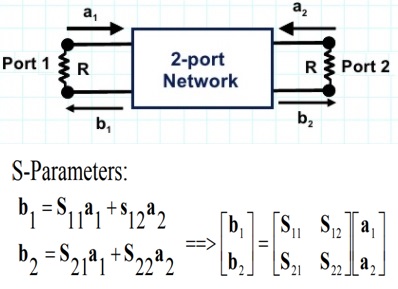Microwave networks consist of many ports. For example, in phased arrays, which are used in 5G wireless communication in base stations, we often have systems that can even have 100s or 1000s of ports, input-output ports. We need to come up with a concept to describe much more complex microwave systems.
K-port microwave networks have K-ports and each port is characterized by a port voltage V_k and a port of current I_k and all these ports, interact with each other. Now, the issue is at microwave frequencies is that it’s not so easy or almost not possible even to measure the voltage and the
currents directly at the port, so that’s not possible, what is possible is to measure the complex amplitude. The amplitude and phase of the incident and reflected waves going into ports using a vector network analyzer, also called VNA. Therefore, we need to describe a 2-port network in terms of the incident and reflected waves.
S-parameters
The scattering matrix is a mathematical construct that quantifies how RF energy propagates through a multi-port network. The S-matrix is what allows us to accurately describe the properties of incredibly complicated networks as simple “black boxes”.
For an RF signal incident on one port, some fraction of that signal gets reflected back out of the incident port, some of it enters into the incident port and then exits at (or scatters to) some or all of the other ports (perhaps being amplified or attenuated). What’s left of that incident power disappears as heat or even electromagnetic radiation. The S-matrix for an N-port contains N2 coefficients (S-parameters), each one representing a possible input-output path.

S-parameters are complex numbers, having real and imaginary parts or magnitude and phase parts, because both the magnitude and phase of the incident signal are changed by the network.
S-parameters are usually displayed in a matrix format, with the number of rows and columns equal to the number of ports. For the S-parameter Sij the j subscript stands for the port that is excited (the input port), and the “i” subscript is for the output port. Thus S11 refers to the ratio of the amplitude of the signal that reflects from port one to the amplitude of the signal incident on port one.




 International Defense Security & Technology Your trusted Source for News, Research and Analysis
International Defense Security & Technology Your trusted Source for News, Research and Analysis
